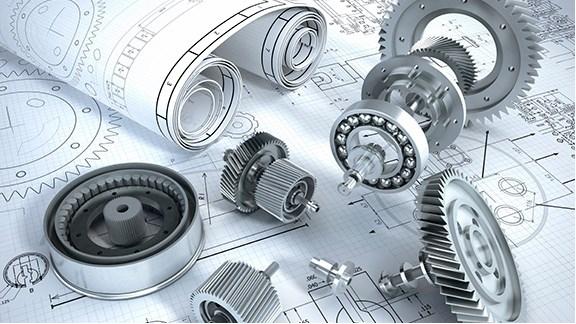

There are various methods by which we can do manufacturing and one of them is Powder Metallurgy. Which comes in a family of production technologies, which process a feedstock in powder form to manufacture components of various types? These production technologies generally involve all or most of the following process steps:

Virtually all iron powders for PM structural part production are manufactured using either the sponge iron process or water atomization. Non ferrous metal powders used for other PM applications can be produced via a number of methods.
This can often involve the introduction of alloying additions in elemental powder form or the incorporation of a pressing lubricant.
The dominant consolidation process involves pressing in a rigid toolset, comprising a die, punches and, possibly, mandrels or core rods. However, there are several other consolidation processes that are used in niche applications.
This process step involves heating of the material, usually in a protective atmosphere, to a temperature that is below the melting point of the major constituent. In some cases, a minor constituent can form a liquid phase at sintering temperature; such cases are described as liquid phase sintering. The mechanisms involved in solid phase and liquid phase sintering are discussed briefly in a later section.
The application of finishing processes to the sintered part. In the Powder Metallurgy industry, such processes are often referred to as “secondary operations”.
Metal powders => Main constituent of a P/M product; final properties of the finished P/M part depends on size, shape, and surface area of powder particles.
Single powder production method is not sufficient for all applications Powder production methods: 1. Mechanical methods, 2. Physical methods,
3. Chemical methods
=> Cheapest of the powder production methods; these methods involve using mechanical forces such as compressive forces, shear or impact to facilitate particle size reduction of bulk materials. Eg.: Milling
During milling, impact, attrition, shear and compression forces are acted upon particles. During impact, striking of one powder particle against another occurs. Attrition refers to the production of wear debris due to the rubbing action between two particles. Shear refers to cutting of particles resulting in fracture. The particles are broken into fine particles by squeezing action in compression force type. Main objective of milling: Particle size reduction (main purpose), Particle size growth, shape change, agglomeration (joining of particles together), solid state alloying, mechanical or solid state mixing, modification of material properties.
Changes in the morphology of powder particles during milling results in the following events.
1. Microforging, 2. Fracture, 3. Agglomeration, 4. Deagglomeration
Microforging: Individual particles or group of particles are impacted repeatedly so that they flatten with very less change in mass
Fracture: Individual particles deform and cracks initiate and propagate resulting in fracture
Agglomeration: Mechanical interlocking due to atomic bonding or vande Waals forces
Deagglomeration: Breaking of agglomerates
The different powder characteristics influenced by milling are shape, size, texture, particle size distribution, crystalline size, chemical composition, hardness, density, flow ability, compressibility, sinter ability, sintered density milling equipment: The equipments are generally classified as crushers & mills.
Crushing: Breaking of agglomerates
For making ceramic materials such as oxides of metals; grinding
For reactive metals such as titanium, zirconium, niobium, tantalum
Grinding: Different types of grinding equipments/methods are shown in the figure Jaw crusher Gyratory crusher Roll crusher Ball Mill Vibratory Ball Mill Attritor Rod Mill Hammer Mill Planetary Mill

Fig. Crushers and various Mills
Ball mills: This contains cylindrical vessel rotating horizontally along the axis. Length of the cylinder is more or less equal to diameter. The vessel is charged with the grinding media. The grinding media may be made of hardened steel, or tungsten carbide, ceramics like agate, porcelain, alumina, zirconia. During rolling of vessel, the grinding media & powder particles roll from some height. This process grinds the powder materials by impact/collision & attrition.
Milling: It can be dry milling or wet milling. In dry milling, about 25 vol% of powder is added along with about 1 wt% of a lubricant such as stearic or oleic acid. For wet milling, 30-40 vol% of powder with 1 wt% of dispersing agent such as water, alcohol or hexane is employed.
Attrition Mill: IN this case, the charge is ground to fine size by the action of a vertical shaft with side arms attached to it. The ball to charge ratio may be 5:1, 10:1, and 15:1. This method is more efficient in achieving fine particle size. Rod mills: Horizontal rods are used instead of balls to grind. Granularity of the discharge material is 40-10 mm. The mill speed varies from 12 to 30 rpm.
Planetary Mill: High energy mill widely used for producing metal, alloy, and composite powders.
Part of powder metallurgy is included in syllabus of Diploma Mechanical engineering and also taught in Top polytechnic colleges in Pune. A model (Thermocol) of ball mill is made by students of Best polytechnic college in Maharashtra which helps to understand working.
P.M.khirapate
Lecturer (Second Shift)
Mechanical Department
Pimpri Chinchwad Polytechnic,Pune